Attention:
- Do not wear the shoulder part of the belt so that it passes under the armpit or is in any other incorrect position.
- Make sure the belt is not twisted.
- The belt provides the most protection when the seatback is in the upright position. When the backrest is reclined, there is an increased risk that the occupant will slip out from under the belt, especially in a frontal collision, and be injured by the belt or by hitting the instrument panel or seatback.
1. To buckle up, slowly pull out the belt while holding it by the tank. Insert the bar into the lock until you hear a click.
Note: If the belt is blocked and does not come out of the spool, pull the belt hard and then avenge it. Then slowly pull the belt out again.
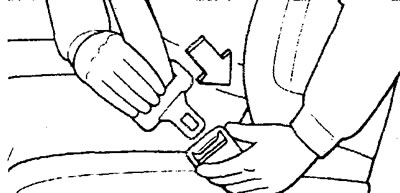
3. Pull the belt out slightly to adjust the desired tension.
Caution: Pregnant women are advised to use their seat belts after consulting a doctor. This will reduce the likelihood of injury to both the woman herself and her unborn child. The waist belt should be as low as possible, under the belly.
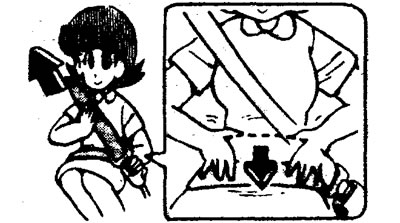
4. To unfasten the belt, while holding the bar, press the button in the lock.
Note: Since the belt retracts automatically, hold it by the bar so that the belt does not retract too quickly. Otherwise, you may damage the vehicle.
5. Use the adjustment bar to adjust the length of the rear seat belt lap.
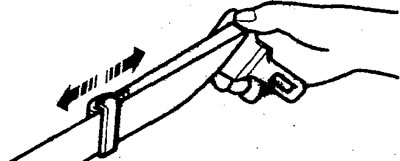
Attention: Do not change the length of the seat belt more than necessary for fastening, as this will reduce the effectiveness of the seat belt.
Adjusting the height of the seat belt attachment point (front seats)
To raise the seat belt anchor point, move the seat belt anchor point up. To lower the seat belt anchor point, press the lock button and slide the seat belt anchor point down to the position that best suits you and release the button. You should hear a click and make sure the seat belt anchor is securely in place.
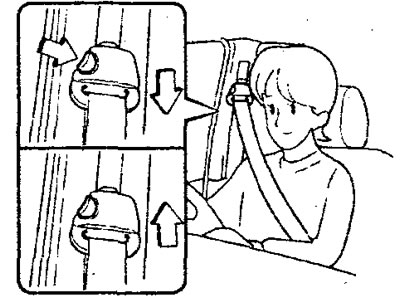
Attention: when adjusting the position of the harness attachment point, position it high enough so that the harness makes full contact with your shoulder, but does not touch your neck.
Installing child seats
1. When transporting children in your car, you should always use child restraints (child seats) of one type or another, depending on the weight and age of the child.
Attention:
- It is recommended to transport children only in the back seat and use special child seats for transportation.
- Holding a child in your arms will not replace a special restraint (child seat).
2. Precautions when installing child seats on vehicles with an airbag (SRS) front naceamtpa.
Attention: Vehicles equipped with a passenger airbag have a warning label attached to it.
A) Do not install a child seat on a front passenger seat that has an airbag in front of it, facing backwards. The force of the passenger's airbag deployment may force the child seat against the seatback, resulting in serious injury.
b) A forward facing child seat must be installed in the rear seat of the vehicle.
V) When installing a child seat in the front seat of a vehicle, move the front seat to the rearmost position.
3. Recommendations when transporting infants and young children.
A) For infants of such a size that the shoulder belt comes into contact with the face or neck when seated, a carrycot should be used instead of the child seat. For younger children, a child seat must be used.
b) holding device (child seat) for children must be appropriate for the weight and height of your child and must be properly installed in the vehicle. To secure the child seat, regular seat belts and special fasteners are used.
V) When installing a child seat, follow the instructions provided by the manufacturer of the device. Failure to follow these instructions could result in serious or even fatal injury to your child.
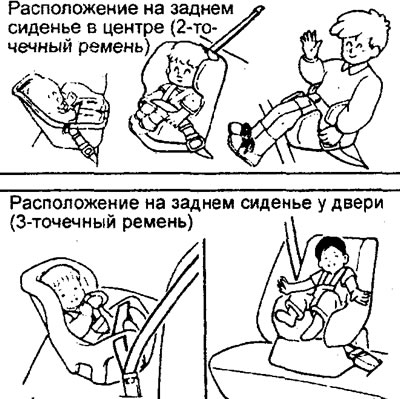
G) When not in use, secure the child seat with the seat belt or remove it from the vehicle so that it does not inadvertently injure your child.
Note: Before purchasing a child seat, check that it fits securely in the rear seat. Sometimes seat belt buckles located on the seat cushion can make it difficult to securely install certain types of child seats. If the child seat can be moved forward on the seat cushion after tightening its belt, select a different child seat.
Attention: For some child seats, the normal fastening of the seat belts may not be sufficient. In this case, use a special belt buckle that will additionally hold the child seat. Install the special buckle in accordance with the child seat manufacturer's instructions.
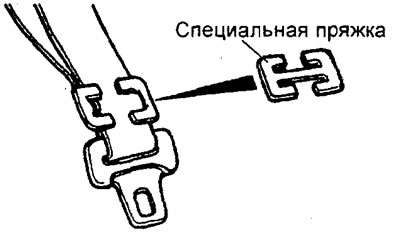
4. Automatic lock activation (mode "ALR") 3-point rear seat belt.
A) To set the mode "ALR" belt after installing the child seat, pull the belt all the way out, then release the belt after a click and let it retract to the position you need. After retracting the belt, a click will be heard, indicating the activation of the mode "ALR" belt (while the belt cannot be pulled out of the inertial coil). Tighten the belt if necessary to remove any slack at the waist.
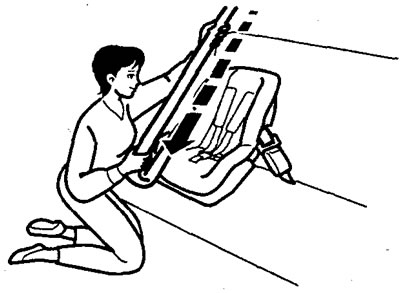
b) To deactivate the mode "ALR" unfasten the belt and allow it to fully retract into the inertia reel, then pull out slightly and release the belt.
Teenagers
Children who are no longer suitable for a child seat must sit in the rear seat and wear the combined lap/shoulder belt.
The waist part of the belt should tightly cover the hips of the child under the pelvis, below the abdomen. Otherwise, in the event of an accident, the belt may cut into the stomach and cause injury to the child.
Attention: Children not wearing seat belts can be thrown out of the car in the event of an accident.
